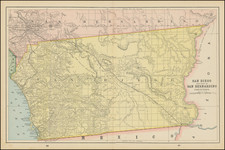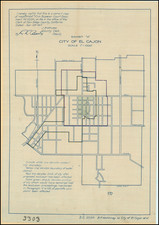Coronado & North Island -- Rancho San Diego Island -- An Early Survey of Coronado and San Diego Bay
An 1880 copy of the original manuscript survey map of Rancho San Diego Island (Coronado) and the area around San Diego Bay, including Point Loma, Coronado, Imperial Beach, and Downtown.
This is an early hand-drawn copy of the original 1867 Henry Hancock survey of the so called Rancho San Diego Island, which was part of the final confirmation of ownership of Coronado and North Island to Archibald C. Peachy and William H. Aspinwall. The present map was drawn by San Diego County Surveyor L.L. Lockling, in June of 1880. The map is also extensively annotated with pencil notes and corrections, likely by use by early surveyors or title companies making reference to the map's details.
The map is composed of careful measurements of the coastline of Imperial Beach and Coronado (at the time North Island and Coronado Island), along with a delineation of Point Loma and the shoreline of the Bay on in what is now Downtown San Diego, National City, etc.
Among the notes on the map is "U.S. Quartermaster's Store House at new San Diego." This shows the location of the future Downtown San Diego in the year Alonzo Horton arrived in San Diego and began what would become the process of developing and promoting modern day San Diego.
There is much interesting detail about the early configuration of the Bay, which has been subject to substantial hydro-engineering and landfilling since this map was made. For instance, North Island and Coronado have long been joined to create one landmass; the strand that connects Imperial Beach and Coronado has been majorly reconfigured.
The map notes many sloughs, sand plats, freshwater springs, dry lakes, high-water lines, bluffs, the deep channel between "U.S. Quartermaster's Store House at New San Diego" and Coronado, etc. Therefore it provides important insight into the natural configuration of a major San Diego geographical feature that no longer exists in that form.
A note on the map reads:
The field notes of the Island and Peninsula of San Diego from which this Plat has been made have been examined and approved and are on file in this Office.
U.S. Surveyor General's Office.
San Francisco Office.
San Francisco California.
January 21st 1868.
The map includes a plethora of amendments in pencil, in another hand, making changes to measurements in both the tables and the map image itself.
Rancho San Diego Island
Rancho San Diego Island (also called "Peninsula of San Diego") was a Mexican land grant given in 1846 by Governor Pío Pico to Pedro C. Carrillo. The grant consisted of the strip of land lying between the San Diego Bay and the Pacific Ocean, which was initially referred to as the Island or Peninsula of San Diego, and which included present day Coronado and North Island.
Pedro C. Carrillo studied law in Boston, where he had been taken by Captain William G. Dana, the husband of Pedro's sister, María Josefa Petra del Carmen. In 1846, Carrillo married Josefa Bandini, daughter of Juan Bandini. Pedro Carrillo and Josefa were given Rancho Peninsula de San Diego by Pio Pico, as a wedding present. Five months later, Carrillo sold the property to Captain Bezer Simmons, the American captain of the trading ship "Magnolia".
Bezer Simmons (1810–1850) of New Bedford, Massachusetts married Laura Billings in 1845. Laura Billings was an older sister of Frederick H. Billings, who accompanied Captain Simmons and his wife, to San Francisco in 1849.
With the cession of California to the United States following the Mexican-American War, the 1848 Treaty of Guadalupe Hidalgo provided that the land grants would be honored. As required by the Land Act of 1851, a claim for Rancho San Diego Island was filed with the Public Land Commission in 1852. Frederick H. Billings, James R. Bolton and Henry Wager Halleck of the law firm Halleck, Peachy & Billings represented Simmons interests. In 1851, the Executors of Bezer Simmons estate sold their interests to William Henry Aspinwall, and the grant was patented to Archibald C. Peachy (a law partner of Simmons Brother-in-Law, Frederick Billings) and William H. Aspinwall in 1869.
William Henry Aspinwall (1807-1875) was a prominent American businessman who was a partner in the merchant firm of Howland & Aspinwall and was a co-founder of both the Pacific Mail Steamship Company and Panama Canal Railway companies which revolutionized the migration of goods and people to the Western coast of the United States.
In 1885, the entire property including North Island, was purchased by Elisha S. Babcock, Jr., Captain Charles T. Hinde, Hampton L. Story, and Jacob Gruendike. Babcock then invited his brother-in-law, Heber Ingle, and Josephus Collett, a railroad stockholder, to become investors, and formed the Coronado Beach Company on April 7, 1886, and started construction on the Hotel del Coronado.
The first development on North Island took place in 1893 when the US government secured about 18 acres and later in 1917, the government took possession of the North Island. On October 25, 1935, the entire area was reserved for the Naval Air Station.
Rarity
The map is a unique survival. We were unable to locate any other examples of either the original 1867 Plat map or any other early copies.
Provenance: We are uncertain of the exact history of the map, but it is believed by its prior owner to have been rescued from the trash by an employee of a Title Company in the 1960s along with a small group of other San Diego related maps.
Henry Hancock was a Harvard trained lawyer and a land surveyor working in California in the 1850s. He was the owner of Rancho La Brea, which included the La Brea Tar Pits.
Hancock studied law at Harvard University. Graduating in 1846, he went St. Louis, Missouri, where he became a surveyor. During the Mexican–American War, he was quartermaster of the 1st Regiment Missouri Mounted Volunteers under Colonel Alexander William Doniphan. At the war's end, he returned home to New Hampshire but soon decided to go west.
Hancock travelled from Chicago to San Francisco, arriving in September, 1849, where he opened a law office. He briefly tried gold mining on American River, but in 1850 moved to Los Angeles.
Hancock engaged extensively in government surveying. Following California's annexation into the United States, the land grants given to Californios by the Spanish and Mexican colonial authorities were required to prove their claims to the new American government. Owners filed claims with the United States Land Commission and had to have their property surveyed and mapped by government surveyors.
Hancock was among the first and most prominent surveyors in Southern California. He served as Deputy Surveyor for the United States, but is better known for his work representing private claimants. He surveyed Rancho San Pedro for the Dominguez family, Rancho San Francisco for the Del Valles, Rancho San Jose owned by the Palomares and Vejar families; and Henry Dalton's Rancho Azusa de Dalton.
Hancock also served as the city surveyor for Los Angeles. He was first employed to do survey work for the city in 1853 to 1854.
On February 5, 1856, the United States Land Commission confirmed four square leagues of land to the City of Los Angeles (using 2.63 miles per league) with the center of the Plaza designated as the center of city land. As United States Deputy Surveyor, Hancock, surveyed the lands confirmed to the City by the United States Land Commission Patent of 1856.
In 1854, Hancock, along with Benjamin Davis Wilson, bought Rancho Rodeo de las Aguas. Hancock was elected to the California State Assembly as a Democrat, representing the 1st District from 1858 to 1860.
As a lawyer, Henry Hancock worked for the Rocha family to aid them with their efforts to prove their claim to Rancho La Brea. The Rochas finally won their claim, but like so many other Californios, their legal expenses left them broke. In 1860 Jose Jorge Rocha, the son of Don Antonio Jose Rocha, deeded Rancho La Brea to Henry Hancock.
During the American Civil War (1861–1865), when there was considerable Confederate sympathy in Southern California, Hancock sided with the Union. He became major of the 4th California Infantry Regiment and for a time was commanding officer of Camp Drum, established to guard against pro-Confederate activities near Los Angeles. He also was sent to Santa Catalina Island to survey it and chose the location for its Union garrison.
After the war, Hancock engaged in the commercial development of the asphaltum deposits on Rancho La Brea. He promoted its use for sidewalk and paving purposes, and shipped considerable quantities to San Francisco by schooner.
In 1863 Hancock married Ida Haraszthy (Ida Hancock Ross), the daughter of Agoston Haraszthy, the "Father of Modern Viticulture in California".
L.L. Lockling was an early San Diego engineer and surveyor.
A contemporary of Alonzo Horton, Lockling Square, San Diego’s first athletic field, bounded by Sixth, Seventh, C, and D (Broadway), was given Lockling for surveying New San Diego.













![(San Diego Water Management) Map of the Dam and Reservoir Site on the Sweetwater River, San Diego County, California belonging to San Diego Land & Town Co. March 1887 [Jamacha Rancho]](https://storage.googleapis.com/raremaps/img/small/97272.jpg)

![[ La Jolla ] La Jolla Street Map](https://storage.googleapis.com/raremaps/img/small/100138.jpg)
![[ Coronado and San Diego ] Bird's Eye View of Coronado Beach, San Diego Bay and City of San Diego, Cal. in Distance. Coronado Beach Company. Capital - One Milion Dollars.](https://storage.googleapis.com/raremaps/img/small/94042.jpg)